Anonimo
While its name may mean ‘anonymous’, the products from Italy’s newest brand are anything but. Visible, innovative, and bold in terms of case size and readability, watches from the Florence-based company are immediately identifiable for their avant-garde technology and the rigour of their design.
We might mention in particular the predilection of Anonimo for technical products (notably its diver’s watches), its carefully finished steel cases, a line of exclusively mechanical movements, and last but not least, the invention of special systems relating to water resistance (the brand holds two international patents).
Behind Anonimo is the experience and direction of Federico Massacesi, a Florentine entrepreneur well known in the small universe of watchmaking. With a small but passionate team of watchmakers and designers, Massacesi has risen to the challenge of confronting the global marketplace. His production is based on quality, far from the whims of fashion, and is deeply attached to the principles of functional rigour and design that are more typical of traditional watchmakers. The brand’s watches are also completely designed and manufactured in Italy.
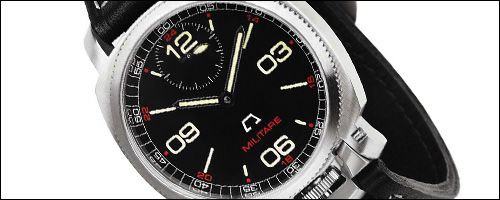
Bulgari
At the beginning of 2004, the Bulgari group launched a three-year plan to develop its watch sector. The first visible result is the realization of a new and important mechanical model signed by the Roman jeweller and presented as an avant-première at this year’s BaselWorld.
It is a tourbillon, with a 64-hour power reserve whose indicator is on the back of the watch and is visible through the transparent sapphire crystal caseback. It also features a round case measuring 38 mm in diameter and is available in a limited series of 25 pieces in both yellow and white gold. Its introduction into the market is expected in the fall of 2004 at an estimated price of around 60,000 euros.
Other projects, however, are in the top secret category for the moment. Francesco Trapani, Bulgari’s CEO, believes that because the luxury sector is cyclic, the brand must innovate, modernize, diversify and increase its production. Take, for example, the automobile, which in periods of crisis or not, always finds new and enthusiastic clients when extraordinary products come to market.
To reach his goals, Trapani is counting not only on the originality of design, since it has always been one of the characteristics of Bulgari, but also on the savoir-faire acquired during his time by the brand’s production unit in Neuchâtel, especially since the integration in 2000 of Gérald Genta and Daniel Roth, which are both strictly watch brands.
Bulgari is becoming one of the world leaders in luxury, with a turnover of some 770 million euros. The segment relating to watches represents about 31% of the total, with jewellery accounting for some 41%, perfume 18%, accessories 8% and royalties about 2%. Production amounts to around 220,000 watches per year (behind Rolex and Cartier) and is distributed in 180 mono-brand boutiques by 700 license holders around the world.
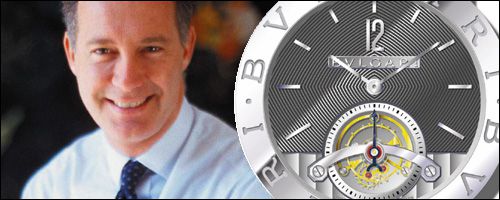
De Bethune
A recent brand that owes its creation to the passion and intervention of David Zanetta, a well known watch collector before becoming a successful entrepreneur, De Bethune has already introduced a veritable world premiere with its own Perpetual Calendar timekeeper.
What makes this watch special is that it shows the lunar phases in a three-dimensional manner, using a sphere in platinum and blued steel that emerges from the dial and rotates on its own axis. It is innovative in terms of technology as well as design, making use of titanium for a number of component parts of the movement as well as the nose-cone shaped lugs on the case.
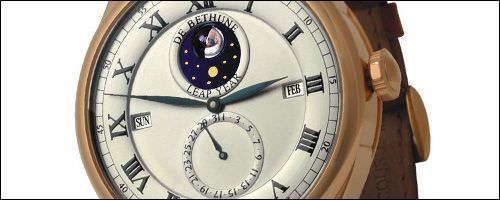
Daniel JeanRichard
This brand carries the name of one of the most important and ingenious watchmakers of all time, the great Daniel Jean-Richard (1655-1741). While maintaining the extraordinary tradition of its namesake, the company has adapted its models to the technical, stylistic and functional demands of today’s consumers. Remarkable for their innovation and quality, JeanRichard timekeepers evoke the ancient methods of this unrivalled artisan who is considered to be the founding father of watchmaking in the canton of Neuchâtel.
JeanRichard is part of the Sowind group and is led by the young Massimo Macaluso, son of Luigi Maccaluso, himself President of Girard-Perregaux. The brand has become noticed for its collections that are innovative on both a stylistic and technical level, and that offer an interesting functional diversity. Today, the haut de gamme Swiss brand (but with Italian management) has taken a decisive step with the announcement of the realization of its own movement. This evolution is not only technological, demonstrating great expertise and savoir-faire, but it is also strategically important in terms of assuring the company an independence that is indispensable for the quality of its production. Entirely planned and produced in-house, under the name JR 1000, this new automatic movement is made from 142 component parts and carries a number of major innovations. Its size offers space for a larger barrel that can offer a longer working reserve and the possibility to set the time with an instantaneous starting of the minute hand.
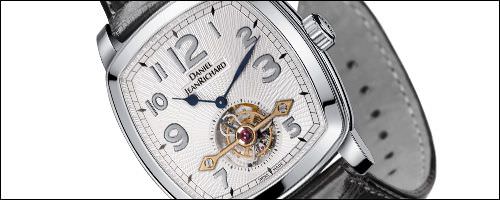
Locman
Initially launched in 1986 to promote readability with its coloured dials and large cases, the watches signed Locman have gradually moved into the area of design and high-tech. They are now experimenting with innovative materials such as carbon fibre worked in three dimensions and titanium.
The current phase of Locman is marked by the decisive abandon of the ‘signature’ concept in favour of restructuring itself as a solid, modern and competitive ‘industrial reality’. The fundamental first step in this direction was the opening of the stores in Milan and Vicenza, signalling the change from a flashy fashion phenomenon to an important production entity in the ‘Made in Italy’ watch arena. Well on its way today, having made an important advance in quality in 1997, Locman enjoys a turnover of around 40 million euros, with a volume of more than 350,000 pieces per year. It has a thousand sales points around the world, as well as mono-brand stores in Florence and Tokyo, with a planned boutique in New York. Its watches are among the trendiest and most recognizable models in the watch industry today.
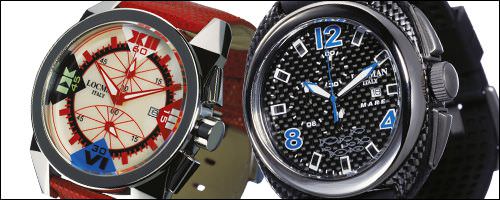
Lorenz
In 2004, Lorenz, one of Italy’s best known brands, is celebrating its 70th anniversary. Its story started at the beginning of 1934, when Tullio Bolletta, founder of Lorenz, opened a small atelier in the centre of Milan, later moving to the Via Montenapoleone, where the brand’s boutique can still be found.
In 1951, Lorenz formed an exclusive alliance with Swiss watchmakers to develop his own watches with an Incabloc balance. The first official recognition came in 1960, with the Compas d’Or prize, awarded for his table clock Static, designed by Richard Sapper.
Starting in the 1990s, the company took on a more international dimension when it presented its models on foreign markets. Today, Lorenz has a turnover of more than 40 million euros and its products are distributed in Australia, Austria, Korea, Croatia, Greece, Malta, the Middle East, Poland, Russia, Slovenia, Spain and Germany where the brand has a direct subsidiary. In 2003, the Chamber of Commerce and Artisanal Industry and Agriculture in Milan conferred the title of ‘Historical Agency of the city of Milan’ on Lorenz.
To celebrate its 70th anniversary, Lorenz is creating a watch in a limited series of 700 pieces. Called ‘Anniversary Theatre’, it features a large steel case (42 mm in diameter) with classic styling. On the technical side, this commemorative piece is equipped with an automatic chronograph movement, based on a Valjoux 7750 calibre, with a working reserve of about 42 hours. The screw-in caseback, made of transparent sapphire crystal that lets the viewer admire the personalized movement, is engraved with the inscription ‘Limited Edition 1934-2004’ and its number in the series.
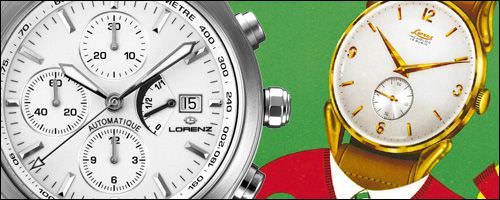
Panerai
The name of Officine Panerai is undeniably linked with the sea. Of Italian origin with watch production in Switzerland, the brand currently belongs to the Richemont Group. Created during the first half of the 20th century, with historic headquarters in Florence, the brand specialized in instruments for professional divers, with particular use among the nation’s navy personnel. After products such as mechanical calculators, depth gauges, compasses and self-lighting devices, Officine Panerai began, in 1938, to produce diver’s watches. These were large models, with luminescent indications and patented devices that ensured water resistance and protection for the crown by means of a special pressure lever. Today, the re-edited versions of these models are among the hottest sellers in the watch industry.
To emphasize its own origins, the brand’s production unit in Neuchâtel (which makes 30,000 certified chronometers per year) recently created a diver’s wrist compass in a limited series of 100 pieces. It reproduces the compasses of the epoch that carried the inscription ‘Incursori di Marina’ – raiders of the Italian navy. A definite collector’s piece, this wrist compass will be joined by a mechanical wrist depth gauge and a new diver’s watch that is water-resistant to 2500 metres. (For more details, see the Cover Story ‘Panerai and the historic Radiomir’ in this issue.)
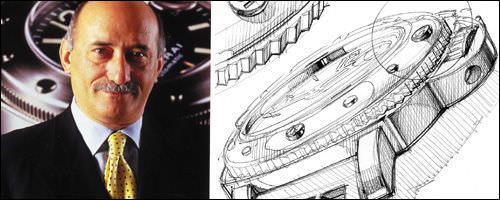
Paul Picot
Distributed in around 30 markets the world over, the brand Paul Picot, headed by Mario Boiocchi, is betting on its ‘mix’ between stylish Italian design and rigorous Swiss technology.
The presentation, last year, of the C-Type 43 mm Chrono and Classique versions was a real international success story and placed the Paul Picot Divers watch, after 20 years of uninterrupted production, into the ranks of the most original and long lasting sports models in recent watchmaking history in Italy. Riding this wave of success, the brand has announced new models in this collection, offering collectors and fans the opportunity to acquire the latest examples with a bezel and minute counter in yellow gold.
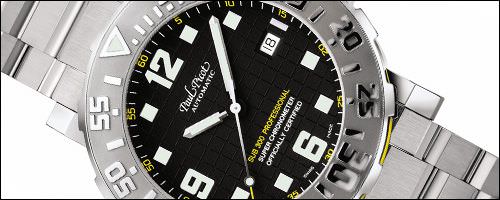
Sector
The champion Andrj Shevchenko, hero of the 17th soccer championship won by Milan, one of the oldest and most successful Italian soccer clubs, is the athlete chosen by Sector to be a ‘testimonial’ for its advertising campaign. Designed by Pirella, this campaign uses the expressive nature of the Ukrainian soccer player in its ads, as well as black and white images to get the message across.
The art direction of Sector has been confided to Franco Bosisio, the man behind the Swatch phenomenon of the 1980s, who enjoys working with this type of marketing. Sector is no newcomer to the game, however, and has had many such testimonials in the past centred on the world of sports and on the extreme concept of ‘No limits’.
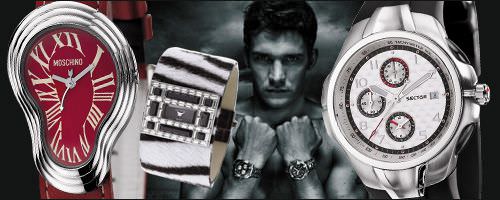
Spazio 24
Spazio 24 is a brand distributed by the Italian company Sclock with Officina del Tempo. Its new watch, TechnoGel derives its name from the material that it is made from. Ultra-resistant to the sun’s rays, to high temperatures and to chemical agents, while remaining non-allergenic, this new material is the primary characteristic of the TechnoGel timepiece. It also features a quartz chronograph movement with a steel case, screw-in caseback, domed mineral glass, and a bezel available in different colours.
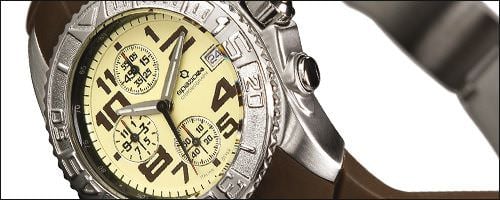
TCM
Three small green mice portrayed in whimsical poses represented the ‘coat of arms’ of the mythical fighter pilots of the 12th squadron of the Italian air force, who flew the Savoia Marchetti 79 aircraft. Beginning in the 1930s, these men distinguished themselves in many sports activities (especially in speed races) as well as in military operations (the best Italian bombardiers during World War II). The three amusing mice have today reappeared on the dial of the AirFirst 47, an automatic chronograph featuring a large case (47 mm) with a military design. Another particularity of this watch is that all the commands (crown, pushbuttons) have been placed on the left. This detail is not only a stylish differentiation but is also an ergonometric decision, since the large size of the case and the onion shaped crown could create problems when moving the wrist if the commands were positioned, as is the rule, on the right.
The AirFirst 47 Chronographe is the latest realization of the TCM brand, whose initials stand for Terra Cielo Mare (land, sky, sea). Created in 2002, the company decided to immediately specialize in watches of a technical and professional nature, with a name that has military connotations from past eras.
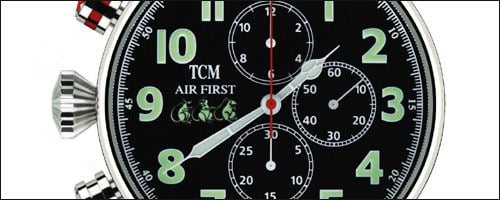
Wyler Vetta
An historic institution with an established educational vocation, known and appreciated not only in Italy, but around the world, the Museum of Science and Technology in Milan includes a series of specialized sections. Among them is a room dedicated to the art of watchmaking.
More or less left abandoned, without renewal of the collections and with no modern exhibition displays, the watch collection of the Milan museum finally found a sponsor to remedy the situation. Wyler Vetta came to the rescue. This brand belongs to the Binda group (owner of Breil, Tribe, Lorus, and distributor of Seiko, Nike Timing and D&G Dolce & Gabbana Time in Italy), which was created in the 1930s by Innocente Binda, who also created the watchmaking room at the museum in Milan.
The inauguration of the restored watch section is expected to take place in the autumn. The major pieces to be showcased will be the reconstruction of Dondi’s astronomical clock and the complete atelier of Bertolla, a major figure in 18th century watchmaking, as well as monastic alarm clocks, lantern clocks and tower mechanisms. The section dedicated to pocket watches will be enlarged and the sponsor will have its own window for its own displays.
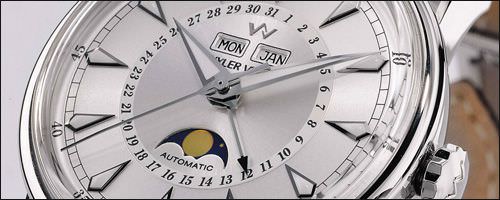
Wintex
When watches opt for the role of fashion accessory or fantasy object, they leave the traditional road of mechanical savoir-faire and enter into the wider streets of design. This is the path chosen by Wintex. The brand’s production evokes the stereotypes of the ‘large brands’, not by simply imitating them, but with the goal of adding style with synthetic stones, bracelets made of gold coloured metal or reptile print straps. It nods towards the more traditional models with a wink of an eye.
Gianni Sutti’s idea (he was once the distributor of Breguet in Italy) is thus to offer accessories that de-dramatize the cult of haute horlogerie (and its prices, too) by opening new avenues of playful amusement. Among the many trendy Wintex models is the Pocket Polso, a spiritual revisit to the classic pocket watch but in a wristwatch version.
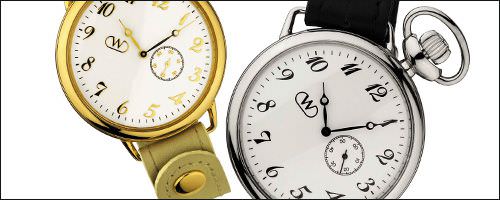
1. Italy: A market in slow recovery
2. What the Italians like best
3. Distribution in Italy
4. A look at the latest from Italy
NEXT...
In the forthcoming weeks, there will be a new Special Market Focus on UK serialized online.
To obtain a print copy subscribe Now to Europa Star.









